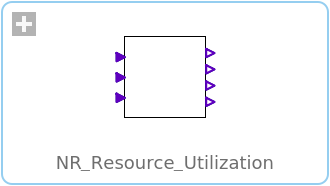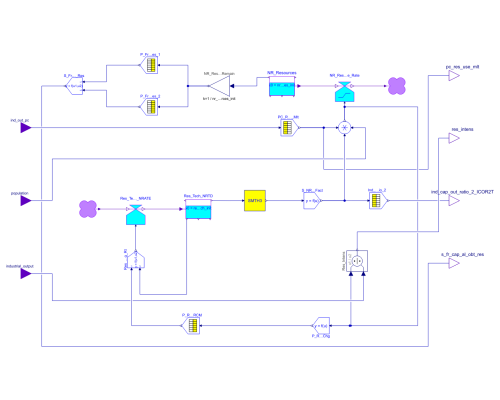WOLFRAM SYSTEM MODELER
NR_Resource_UtilizationUtilization of non-recoverable natural resources |
|
Diagram
Wolfram Language
SystemModel["SystemDynamics.WorldDynamics.World3.NR_Resource_Utilization"]

Information
From today's perspective, it might make more sense to concentrate on the remaining fossil fuels, which is not the approach that Meadows and his coworkers took. Yet, the effects of the dwindling resources on the overall economy are comparable, whether we can no longer produce goods, because we lack the raw materials or because we lack the energy to do so, results ultimately in the same predicament. Due to the laws of exponential growth, we are running out of all kind of natural resources (fossil fuels, minerals, fresh water) almost simultaneously.
In the case of minerals, recovery is partly possible, as discarded materials can be recycled. However doing so requires energy for the re-concentration of these scrap materials. The materials themselves don't get used up. They only get dissipated further and further, until their density is so low that they cannot be collected any longer within reasonable cost limits.
In the case of fossil fuels, these truly get used up. These resources are non-recoverable within human time constants. They were developed over many millions of years and essentially represent "fossil sunshine." Humanity is using all of these resources up within the very short time span (in geological terms) of a few hundred years. Peak Oil, i.e., the time when we shall have used up 50% of the available oil, and when supply can no longer keep up with demand, is now just around the corner.
The fantastic recent developments of technology and the medical sciences, accompanied by an unprecedented growth of human population, would not have been possible without these resources, and won't be maintainable, once they shall have been used up.
Whereas the earlier WORLD2 model only accounted for the dwindling resources themselves, the newer WORLD3 model offers a second state variable representing technological change. Through more advanced technology, it is possible to use the available resources more efficiently, and that effect is accounted for by the second state variable in the model.
In the WORLD3 model, the natural resources themselves are measured in metric tons, whereas the technology change has no units.
Parameters (9)
| des_res_use_rt_DNRUR |
Value: 4800000000.0 Type: Real (ton/yr) Description: Desired resource utilization rate |
|---|---|
| nr_resources_init |
Value: 1000000000000.0 Type: Real (ton) Description: Initial available non-recoverable resources |
| p_nr_res_use_fact_1 |
Value: 1 Type: Real Description: Default non-recoverable resource utilization factor |
| res_tech_init |
Value: 1 Type: Real Description: Initial non-recoverable resource technology factor |
| t_policy_year |
Value: 4000 Type: Real (yr) Description: Year of policy change |
| t_fcaor_time |
Value: 4000 Type: Real (yr) Description: Year of capital allocation to resource use efficiency |
| tech_dev_del_TDD |
Value: 20 Type: Real (yr) Description: Technology development time |
| p_fr_cap_al_obt_res_2 |
Value: {1, 0.2, 0.1, 0.05, 0.05, 0.05, 0.05, 0.05, 0.05, 0.05, 0.05} Type: Real[:] Description: Non-renewable resource fraction remaining |
| p_res_tech_chg_mlt |
Value: {0, 0, 0, 0} Type: Real[:] Description: Resource technology change multiplier |
Connectors (7)
| ind_out_pc |
Type: MassInPort Description: Per capita annual industrial output |
|
|---|---|---|
| population |
Type: MassInPort Description: Population |
|
| pc_res_use_mlt |
Type: MassOutPort Description: Per capita resource utilization |
|
| s_fr_cap_al_obt_res |
Type: MassOutPort Description: Fraction of capital allocated to resource use efficiency |
|
| ind_cap_out_ratio_2_ICOR2T |
Type: MassOutPort Description: Industrial capital output ratio |
|
| industrial_output |
Type: MassInPort Description: Annual industrial output |
|
| res_intens |
Type: MassOutPort Description: Resource utilization intensity |
Components (19)
| NR_Resources |
Type: Level1b Description: p.387 of Dynamics of Growth in a Finite World |
|
|---|---|---|
| NR_Res_Use_Rate |
Type: RRate Description: p.389 of Dynamics of Growth in a Finite World |
|
| Sink1 |
Type: Sink Description: This is the (dummy) sink model of System Dynamics |
|
| NR_Res_Use_Rt |
Type: Prod_3 Description: p.389 of Dynamics of Growth in a Finite World |
|
| S_NR_Res_Use_Fact |
Type: S_NR_Res_Use_Fact Description: p.390 of Dynamics of Growth in a Finite World |
|
| P_Nr_Res_Use_Fact_2 |
Type: SMTH3 Description: Third-order exponential smoothing |
|
| Res_Tech_NRTD |
Type: Level1a Description: General System Dynamics level with no outflow |
|
| Res_Tech_Ch_Rt_NRATE |
Type: Rate_1 Description: Unrestricted rate element with one influencing variable |
|
| Source1 |
Type: Source Description: This is the (dummy) source model of System Dynamics |
|
| Res_Tech_Chg_Rt |
Type: Res_Tech_Ch_Rt_NRATE Description: Non-recoverable resource technology change rate |
|
| P_Res_Tech_Chg_Mlt_NRCM |
Type: Tabular Description: Tabular function |
|
| P_Res_Tech_Chg |
Type: P_Res_Tech_Chg Description: Percentage of effective resource technology change |
|
| PC_Res_Use_Mlt |
Type: Tabular Description: p.390 of Dynamics of Growth in a Finite World |
|
| NR_Res_Fr_Remain |
Type: Gain Description: p.393 of Dynamics of Growth in a Finite World |
|
| P_Fr_Cap_Al_Obt_Res_1 |
Type: Tabular Description: p.394 of Dynamics of Growth in a Finite World |
|
| P_Fr_Cap_Al_Obt_Res_2 |
Type: Tabular Description: p.394 of Dynamics of Growth in a Finite World |
|
| S_Fr_Cap_Al_Obt_Res |
Type: S_Fr_Cap_Al_Obt_Res Description: p.393 of Dynamics of Growth in a Finite World |
|
| Ind_Cap_Out_Ratio_2 |
Type: Tabular Description: Tabular function |
|
| Res_Intens |
Type: Division Description: Output first input divided by second input |
Used in Examples (11)
|
SystemDynamics.WorldDynamics.World3 Original WORLD3 model |
|
|
SystemDynamics.WorldDynamics.World3 More abundant non-recoverable natural resources |
|
|
SystemDynamics.WorldDynamics.World3 More accessible non-recoverable natural resources and pollution control |
|
|
SystemDynamics.WorldDynamics.World3 More accessible non-recoverable natural resources, pollution control, and land yield enhancement |
|
|
SystemDynamics.WorldDynamics.World3 More accessible non-recoverable natural resources, pollution control, land yield enhancement, and erosion protection |
|
|
SystemDynamics.WorldDynamics.World3 More accessible non-recoverable natural resources, pollution control, land yield enhancement, erosion protection, and resource efficiency |
|
|
SystemDynamics.WorldDynamics.World3 More abundant non-recoverable natural resources and birth control |
|
|
SystemDynamics.WorldDynamics.World3 More abundant non-recoverable natural resources, birth control, and stable industrial output |
|
|
SystemDynamics.WorldDynamics.World3 Combining the measures of Scenarios #6 and #8 |
|
|
SystemDynamics.WorldDynamics.World3 Influencing the future 20 years earlier |
|
|
SystemDynamics.WorldDynamics.World3 Influencing the future 10 years later |

